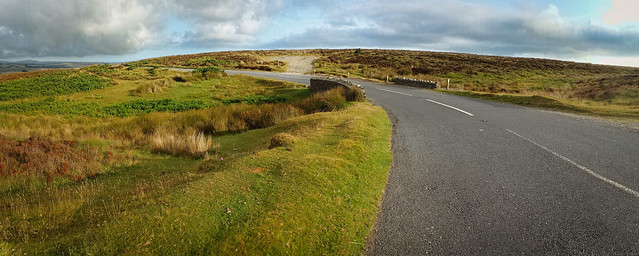 The North Devon coast around Lynmouth
The North Devon coast around Lynmouth“Yeah a lot of people bring bicycles here” said the guy we were renting our holiday cottage from “they usually put them back on the car after the first day.”
As a newbie cyclist with a relatively shiny and new bike, I began to wonder if I had made a big mistake, and that enduring the anxiety of transporting my steed on the car roof had not been worth it (carbon frames and roof carriers – a subject in itself). At sea level beneath the cliffs of North Devon, Lynmouth is surrounded by steep slopes overlain with precipitous roads. Even driving here is hairy enough, as is testified by the frequent acrid wafts from overheated clutches.
There must be some kind of way out of here
 Lynmouth at dusk
Lynmouth at duskThere are three principal ways to cycle out of Lynmouth. Two are insane:
- Lynmouth Hill (featuring a two extremely steep sections in the first kilometres where the gradient exceeds 30% at times), and
- Countisbury Hill (not quite as steep but more relentless).
This is the sort of steepness where you can find your front wheel lifts off the tarmac when making a pedal stroke. As has been wisely written, any gradient > 16% is “very challenging for riders of all abilities. Maintaining this sort of incline for any length of time is very painful”.
The third way however, looked doable. It is a climb featured as Number 6 in Simon Warren’s excellent book 100 Greatest Cycling Climbs. It has just one steepish (~10%) section, but overall a gentle average. At 11km it is however lengthy. On a scale of 1 to 11 this – the “Exmoor Forest” climb – is one of the easiest in Mr Warren’s book with a rating of 3/10. Challenge enough for me. The best cyclists do it in around 30 minutes; as a rule of thumb I try to beat twice their time.
Biological, mechanical & electronic considerations
Cycling has many dimensions. There are all those great (and perhaps not so great) sensations: the feeling of flying at speed, the views, the pain – but, if you like, there are also many more technical aspects around the bike machinery and biomachinery that is to be used. As a self-confessed geek these are of interest to me, particularly when applied to cycling climbs.
The bike itself has a couple of key elements. First, its weight. This is hard to change much for any given bike, reducing it beyond the ~10kg or so of a typical ridable modern carbon-fibre bike is done with rapidly diminishing returns. Secondly, the gearing – having an appropriate range of easy low gears can make the difference between a climb being even possible or not. I opted to fit a 12–30 tooth cassette to match my 50/34 front chainrings, giving the option of some slightly higher gearing than is typically available from a default bike shop purchase. This gives a lowest gearing of 30 gear inches, or, put another way means that turning the pedals at a (very slow) 40 rpm, one travels at a walking pace of ~5.5 km/h – fast enough to stay upright and make slow progress.
However, as the clever saying has it, getting better is not a matter of buying upgrades, but of cycling up grades. Of far more importance than the bike is the rider. To achieve my goal of completing the climb without stopping the task was simply stated: be able to turn the pedals fast enough to keep the bike moving, for long enough to complete the ride. Assuming a resaonable technique and no drug use, the two main factors affecting this are weight and fitness. If losing weight from a bike is expensive and difficult, losing body weight is comparatively cheap and easy. However, in the short term I was stuck with being a comfortable 72 kg – and this wouldn’t be going down shortly, particularly in view of the local delights on offer. As to fitness: well, we would see: I had been cycling for a few months, and on occasions for some distance, but in the decidely unhilly county of Cambridgeshire. Primarily, cycle climbing is a test of fitness.
 When you reach the moor itself the gradient eases.
When you reach the moor itself the gradient eases.The climb
The climb is in three parts, starting in the gorge for around 4 km and emerging onto Exmoor for the final 6 km or so. In between is a transitional section through woodland.
Gorge part – After a short steep ramp past the last houses of the village, the first section is a fairly steady slog. The rushing river below makes you think there’s a car coming from behind all the time, but on the three occasions I rode this route I saw only a handful of cars. Beware however, as the road is narrow and all caravan traffic is directed this way: some of it is driven by drivers freaked-out by the challenging (for Britain) roads.
The woodland part – You leave the A39 and turn onto the B3223, passing over a small bridge: this is the second part of the climb, and its core challenge. The road is well-tarmacced but knobbly and soon the gradient starts steepening.
The moorland part – …and once past the hairpin, the climb is defeated, as the gradient progressively slackens and there even one or two stretches of level road before passing over some cattle grids and reaching ...
The summit
the “summit” itself is a rather unmomentous spot with no distinguishing features other than the road beginning to slope downhill again.
After a failed first attempt in pouring rain, when the second part of the climb defeated me, I tried again in better weather and succeeded in completing the climb in just under 54 minutes. Knowing what was in store at each stage was a great help because if cycling is a test of fitness, it is perhaps almost as much a test of the mind.